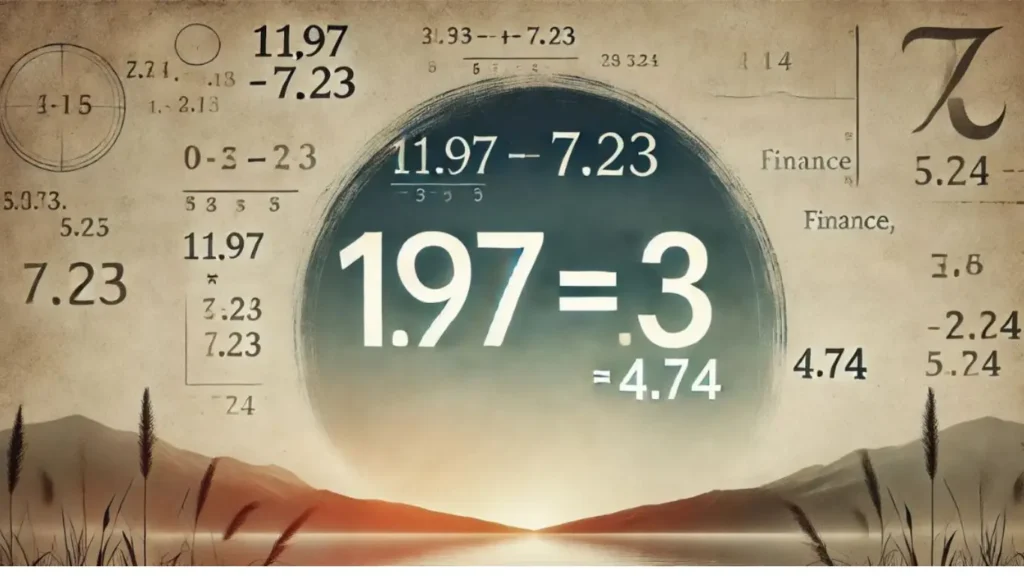Numbers often carry significance beyond their mathematical value. Whether in finance, technology, engineering, or daily transactions, small differences in numerical values can have a substantial impact. But what exactly distinguishes 11.97 from 7.23? Let’s explore various perspectives to provide clarity.
Mathematical Perspective
At the core, 11.97 is greater than 7.23 by 4.74. This basic subtraction illustrates a numerical difference, but its implications vary depending on context. In algebra, these values might be used in equations to determine trends or projections. In probability, they could define outcomes with significant variations.
Financial Relevance
In finance, these numbers could represent stock prices, interest rates, or monetary values. A stock priced at 11.97 versus 7.23 suggests a difference in market valuation. Similarly, interest rates with such variations can significantly influence loan repayments and investment returns.
For investors, a seemingly small change in stock value can result in large financial gains or losses over time. The psychological perception of these numbers also plays a role—prices closer to round figures tend to attract more buyers.
Measurement and Engineering Implications
Precision matters in fields like construction and engineering. A difference of 4.74 units might be negligible in some scenarios but crucial in others.
For instance, in product dimensions, even a small variation can impact compatibility and performance. Consider a machine component requiring specific measurements; even a millimeter off can cause malfunctions or inefficiencies.
Similarly, in the medical field, numerical differences in dosages can mean the difference between a successful treatment and potential harm.
Psychological and Consumer Behavior Angle
If 11.97 and 7.23 are prices, consumer behavior comes into play. A product priced at 7.23 might be perceived as more affordable than one at 11.97, influencing purchasing decisions. Psychological pricing strategies leverage such differences to attract customers.
Businesses use numerical tactics to impact consumer perception; for example, prices ending in .97 or .99 often seem lower than they actually are, making them more appealing to buyers.
This pricing strategy is commonly seen in retail, marketing, and e-commerce platforms where subtle differences drive significant consumer response.
Scientific and Statistical Interpretation
In data analysis and scientific research, numerical variations like this could represent statistical deviations, probabilities, or measured outcomes. Understanding these differences is essential in fields such as medical research, environmental studies, and AI model accuracy. A seemingly small numerical deviation can influence research conclusions and affect policy decisions.
For example, a difference in temperature readings between 11.97°C and 7.23°C could signify climate shifts, which in turn influence ecological and human activities.
The Role of Numbers in Everyday Decisions
Beyond finance and science, these numbers hold importance in everyday life. Consider a scenario where a runner aims to complete a race within a specific time frame—each decimal point of a second can define their success.
Likewise, in personal budgeting, distinguishing between 11.97 and 7.23 in pricing can influence purchasing choices, leading to better financial management.
Why Does This Matter to You?
Whether you encountered these numbers in a search for product pricing, stock analysis, or scientific data, the underlying difference impacts decision-making. By understanding context, you gain better insights into their significance.
The ability to interpret numbers in various contexts empowers individuals to make informed decisions, from buying a household item to investing in stocks or analyzing research data.
Final Thoughts
Numbers tell a story. The difference between 11.97 and 7.23 extends beyond mere subtraction—it holds financial, psychological, engineering, and scientific value. Recognizing these distinctions empowers informed choices in various aspects of life. Next time you come across such numbers, consider their deeper implications and how they shape the world around you.


